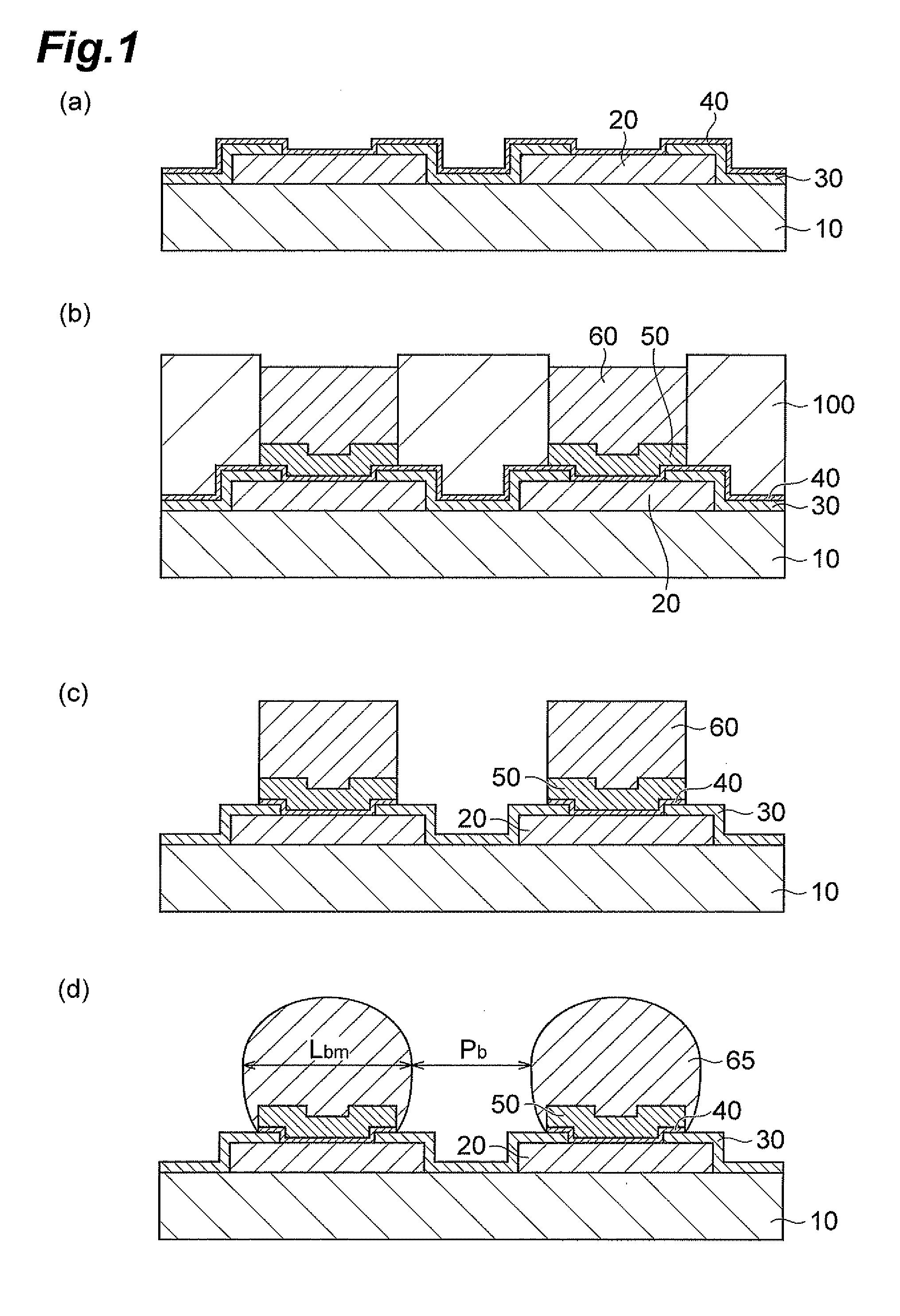Terminal structure and semiconductor device
a technology of terminal structure and semiconductor device, which is applied in the direction of semiconductor device, semiconductor/solid-state device details, electrical apparatus, etc., can solve the problems that the use of the aforementioned conventional bumps cannot meet the need for bump pitch reduction, limits the potential bump pitch reduction, and the bump base portion may not be sufficiently wrapped around the bump base portion at mounting, so as to suppress the risk of bump shorting, the effect of bump pitch
- Summary
- Abstract
- Description
- Claims
- Application Information
AI Technical Summary
Benefits of technology
Problems solved by technology
Method used
Image
Examples
example 1
[0064](Substrate Preparation)
[0065]There was prepared a silicon substrate (5×5 mm, 0.6 mm thick) on which an external electrode and a SiN insulating coating layer having an opening are formed as illustrated in FIG. 2(a). Note that the external electrode was made of copper and the 10×10 openings were arranged so as to be equally spaced from each other. In addition, the silicon substrate was prepared such that the external electrode was pre-wired so as to form a daisy circuit at mounting in order to confirm conductivity at a heat cycle test to be described later.
[0066](Electroless Nickel Plating)
[0067]Then, predetermined pretreatments (degreasing, pickling, and activating treatments) were performed on a copper external electrode surface exposed in an opening of the SiN insulating coating layer, followed by electroless nickel plating, to form a UBM layer filling the opening and covering part of the SIN insulating coating layer (FIG. 2(b)). Note that as the electroless nickel plating, a...
examples 2 to 6
[0077]In the same manner as in example 1 except that the thickness, the pitch, and the like of each component were changed as shown in Table 1, there was obtained a silicon TEG substrate comprising a terminal structure as illustrated in FIG. 2(d).
example 7
[0078]In the same manner as in example 1 except that electrolytic nickel plating was performed instead of electroless nickel plating, there was obtained a silicon TEG substrate comprising a terminal structure as illustrated in FIG. 3(d).
[0079]The electrolytic nickel plating was performed in the following manner. First, a 0.1 μm thick copper layer was formed as a seed layer by sputtering on the copper external electrode surface exposed in the SiN insulating coating layer opening and the SiN insulating coating layer surface (FIG. 3(a)), and then a dry film was formed. Subsequently, the dry film was patterned by photoresist to remove the dry film around the SiN insulating coating layer opening. Then, electrolytic nickel plating was performed on the external electrode surface exposed in the SiN insulating coating layer opening and part of the insulating coating layer surface to form the UBM layer (FIG. 3(b)). Then, the dry film was stripped and an unnecessary seed layer was removed to f...
PUM
 Login to View More
Login to View More Abstract
Description
Claims
Application Information
 Login to View More
Login to View More - R&D
- Intellectual Property
- Life Sciences
- Materials
- Tech Scout
- Unparalleled Data Quality
- Higher Quality Content
- 60% Fewer Hallucinations
Browse by: Latest US Patents, China's latest patents, Technical Efficacy Thesaurus, Application Domain, Technology Topic, Popular Technical Reports.
© 2025 PatSnap. All rights reserved.Legal|Privacy policy|Modern Slavery Act Transparency Statement|Sitemap|About US| Contact US: help@patsnap.com



